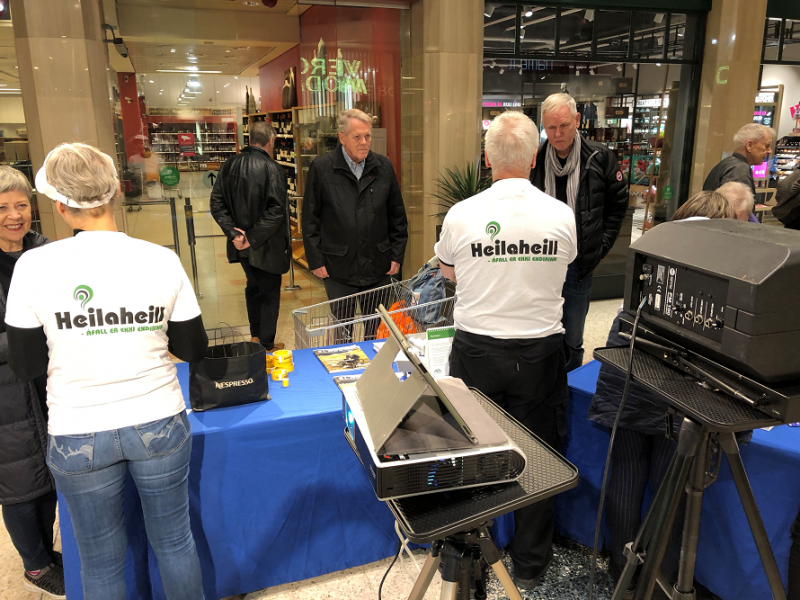Caption: On the International Stroke Day 2018 our members HEILAHEILL, patients, neurologists, etc. to promote the disease and disseminate information to the public in KRINGLUNNI, Reykjavik’s largest shopping center, which attracted much attention. Chairman of HEILAHEILL Thorir Steingrimsson and the specialist in neurology (thrombectomy) Bjorn Logi Thorarinsson in National University Hospital of Iceland | LSH · Department of Neurology.
“According to circumstances in ICELAND we are unable to make significant survey on prevention, treatment and rehabilitation of the stroke or exploring the burden of the stroke because we have only 360.000 citizens. Therefor it is difficult for the authorities to answer our queries about the incidence of stroke across the country. But however we are trying to follow Stroke Action Plan for Europe 2018-2030 by taking the guidance of professionals and health authorities” says the Chairman of HEILAHEILL, Icelandic stroke support organisation, Thorir Steingrimsson.
SAFE: What is one issue related to the life after stroke in your country that you think needs special attention?
TS: Being in SAFE gives us the opportunity to compare ourselves with other health systems in other European countries regarding the stroke. Many things are similar to us and the other Nordic countries, but there are a number of factors that are similar to the burden of the stroke with other nations, for example there is a lack of follow-up from the healthcare system, when individuals are enrolled in the community. The main problem in our country is that the health authorities and ÖBÍ (The Organisation of Disabled in Iceland) which we accept money from, do not recognize aphasia after stroke as a special disability category in the healthcare system, but it is mixed with aphasia due to age or other trauma. The majority of those who have aphasia after stroke in our country do not experience themselves as ratifying the citizens of society. It is a great shame. Therefore, HEILAHEILL has worked with professional, speech therapists and other patient associations to raise the awareness of the health authorities and the public of this disability. We realize that this is starting to work, as the current government is beginning to recognize the problem i.a. support us financially specifically in equating education with this disability category
SAFE: What would be the solution, i.e. what is your organisation’s position regarding this issue?
TS: We still have opportunity to do many things, which larger nations find difficult to do, for example make a plan for decision party about stroke treatments over the hole country. In comparison, we can be likened to a little drill next to a big oil ship.
Healthcare professionals have done tremendous progress in thrombectomy, over the past two years in Landspítali in Reykjavík, which is the largest and leading factor in healthcare in the country and estimate it to be national 2020! HEILAHEILL has decided to introduce this improvement among the public and in the country and use this opportunity to raise public awareness of the first signs of stroke and and urges the public to push the government to put more money into reducing the burden of a stroke!
SAFE: Please tell us more about your organisation.
TS: HEILAHEILL is a independent companionship for stroke survivors with individual membership for the whole country. The company have opportunity to meet the decision-makers by the authorities face-to-face, and they have supported us in our policy and it is also close relationship between people In HEILAHEILL and professionals over the country.
Therefore there is compelling evidence in ICELAND that stroke is highly preventable, treatable and manageable, and there is a potential to drastically decrease the burden of stroke, including substantially reducing its long-term consequences. This requires the joint actions of Ministries of Health and Social Care, other governmental bodies, scientific and stroke support organisations, healthcare professionals, clinical and preclinical researchers and industry and most of all, a good and powerful communication with patient organizations.
The benefits of tPA in patients with acute ischemic stroke are time-dependent, and guidelines recommend a door-to-needle time of 60 minutes or less. Professionals in Iceland say the average has dropped from 80 minutes to 25 minutes in the last three years!
HEILAHEILL has released an app in smartphones with information on the first signs of stroke. And when it is inserted in the beginning you place your social security number, it makes it your personal safety button to the emergency line and they positioning the device with precision. The smartphone tells who is calling for help, age, gender, wherever you are in the country!





